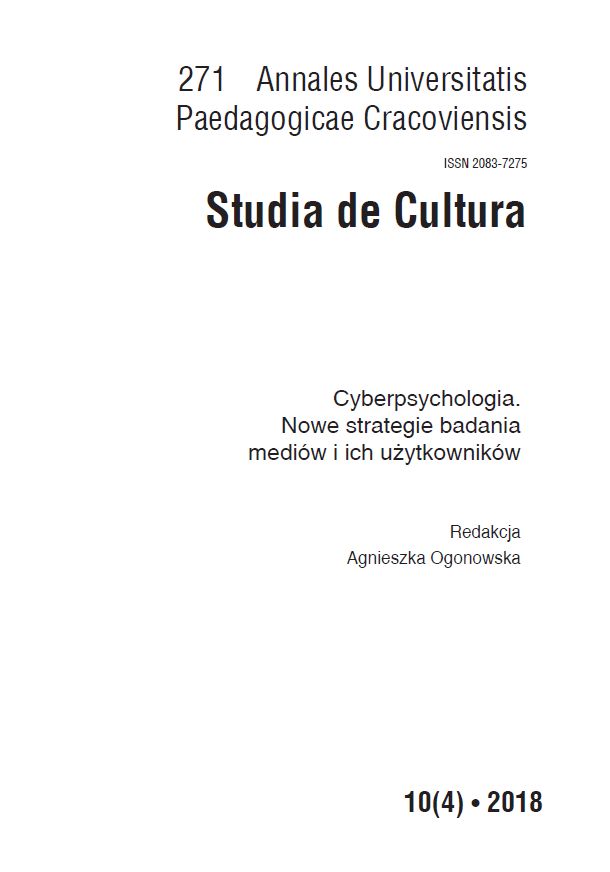Abstrakt
DOI 10.24917/20837275.10.4.4
Niniejszy artykuł podejmuje tematykę zjawiska problematycznego używania internetu (PUI) wśród adolescentów i osób na etapie wczesnej dorosłości. Sam koncept w oparciu o model diateza-stres zakłada istnienie czynników sprzyjających wystąpieniu tego zjawiska. Za takie czynniki postuluje się uważać cechy osobowości oraz wczesne nieadaptacyjne schematy, które jako względnie trwałe na przestrzeni życia mogą stanowić czynnik zagrażający. Warte zaznaczenia jest to, że PUI nie jest zjawiskiem jednowymiarowym lecz uwzględnia preferencję kontaktów online, (w odróżnieniu od tych rzeczywistych), negatywne następstwa bycia w sieci, aspekt kompulsywności oraz samoregulację nastroju poprzez przebywanie w necie.
Problematic Internet use in relation to personality traits and early maladaptive patterns of net users
Abstract
This article deals with the phenomenon of Problematic Internet Use among adolescents and people in the stage of early adulthood. The concept based on the diathesis model of stress assumes the existence of factors conducive to the occurrence of this phenomenon. Such factors are postulated as personality traits and early maladaptive schemas that may be a threatening factor as relatively persistent over the course of life. An important point is that the Problematic Internet Use takes into account the preference of on-line contacts apart from the real ones, negative consequences, the aspect of compulsiveness and self-regulation of mood through the network.
Bibliografia
Arntz Arnoud, Gitta Jacob. 2017. Schema therapy in practice: An introductory guide to the schema model approach. Hoboken.
Zobacz w Google Scholar
Bach Bo, Lee Christopher, Mortensen Erik Lykke, Simonsen Erik. 2016. “How do DSM-5 personality traits align with schema therapy constructs?”. Journal of personality disorders nr 30(4). 502–529.
Zobacz w Google Scholar
Bamelis Lotte, Evers Silvia, Spinhoven Philip, Arntz Arnoud. 2014. “Results of a multicenter randomized controlled trial of the clinical effectiveness of schema therapy for personality disorders”. American Journal of Psychiatry nr 171(3). 305–322.
Zobacz w Google Scholar
Białokoz-Kalinowska Irena, Kierus Karolina, Nawrocka Beata, Piotrowska-Jastrzębska Janina Danuta. 2011. „Uzależnienie od Internetu (siecioholizm) wśród młodzieży licealnej – konsekwencje zdrowotne i psychospołeczne”. Pediatria i Medycyna Rodzinna nr 7(4). 372–377.
Zobacz w Google Scholar
Caplan Scott E. 2010. “Theory and measurement of generalized problematic Internet use: A two-step approach”. Computers in Human Behavior nr 26(5). 1089–1097.
Zobacz w Google Scholar
Costa Jr Paul T., McCrae Robert R. 2017. “The NEO Inventories as instruments of psychological theory”. The Oxford Handbook of the Five Factor Model 11.
Zobacz w Google Scholar
Gałuszka Anita. 2014. Rola cyberprzestrzeni w uldze i cierpieniu współczesnego człowieka. W Współczesne społeczeństwo w wirtualnej rzeczywistości – wielość szans i dylematów. Z. Dacko-Pikiewicz, M. Walancik (red.). (cz. III). Kraków. 221–233.
Zobacz w Google Scholar
Hoffart Lunding, Synve, Hoffart Asle. 2016. “Perceived parental bonding, early maladaptive schemas and outcome in schema therapy of cluster c personality problems”. Clinical Psychology & Psychotherapy nr 23 (2). 107–117.
Zobacz w Google Scholar
Kahl Kai G., Winter Lotta, Schweiger Ulrich. 2012. “The third wave of cognitive behavioural therapies: what is new and what is effective?”. Current opinion in psychiatry nr 25 (6). 522–528.
Zobacz w Google Scholar
Kim Sang Hee, Hamann Stephan. 2007. “Neural correlates of positive and negative emotion regulation”. Journal of cognitive neuroscience nr 19(5). 776–798.
Zobacz w Google Scholar
Kirwil Lucyna. 2011. Polskie dzieci w Internecie. Zagrożenia i bezpieczeństwo cz. 2. Częściowy raport z badań EU Kids Online przeprowadzonych wśród dzieci w wieku 9–16 lat i ich rodziców. Warszawa.
Zobacz w Google Scholar
Ko, Chih-Hung et al. 2015. “Bidirectional associations between family factors and Internet addiction among adolescents in a prospective investigation”. Psychiatry and clinical neurosciences nr 69(4). 192–200.
Zobacz w Google Scholar
Kudryavtsev Michaił D., Kramida I.E., Iermakov Sergii S. 2016. “Influence of studying in higher educational establishment on students’ harmful computer habits”. Physical education of students nr (5). 17–23.
Zobacz w Google Scholar
Li Dongping et al. 2016. “Stressful life events and adolescent Internet addiction: The mediating role of psychological needs satisfaction and the moderating role of coping style”. Computers in Human Behavior nr 63. 408–415.
Zobacz w Google Scholar
Mącik Dorota. 2016. „Wczesne nieadaptacyjne schematy Younga i ich związki z rysami zaburzeń osobowości w populacji nieklinicznej – badania wstępne”. Psychiatria i Psychoterapia nr 12(1). 3–24.
Zobacz w Google Scholar
McCrae Robert R. 2018. ”Method biases in single-source personality assessments”. Psychological Assessment nr 30(9). 1160–1173.
Zobacz w Google Scholar
Montgomery-Graham Stephanie. 2016. “DBT and schema therapy for borderline personality disorder: Mentalization as a common factor”. Journal of Contemporary Psychotherapy nr 46 (1). 53–60.
Zobacz w Google Scholar
Nordahl Hans M., Nysæter Tor E. 2005. “Schema therapy for patients with borderline personality disorder: a single case series”. Journal of Behavior Therapy and Experimental Psychiatry nr 36 (3). 254–264.
Zobacz w Google Scholar
Oettingen Justyna, Chodkiewicz Jan, Mącik Dorota, Gruszczyńska Ewa. 2017. ”Polish adaptation of the Young Schema Questionnaire 3 Short Form (YSQ-S3-PL)”. Psychiatria Polska nr (82). 1–12.
Zobacz w Google Scholar
Orsmond Gael I., Seltzer, Marsha Mailick. 2009. “Adolescent siblings of individuals with an autism spectrum disorder: Testing a diathesis-stress model of sibling well-being”. Journal of autism and developmental disorders 39(7). 1053–1065.
Zobacz w Google Scholar
Pirandola Stefano, Braunstein Samuel Leon. 2016. “Unite to build a quantum internet”. Nature vol. 532. 169–171.
Zobacz w Google Scholar
Renner Fritz et al. 2018. “Exploring mechanisms of change in schema therapy for chronic depression”. Journal of behavior therapy and experimental psychiatry nr 58. 97–105.
Zobacz w Google Scholar
Seah May-li, Cairns Paul. 2008. From immersion to addiction in videogames. In Proceedings of the 22nd British HCI Group Annual Conference on People and Computers: Culture, Creativity, Interaction – Vol. 1. Liverpool. 55–63.
Zobacz w Google Scholar
Sorokowska Agnieszka, Słowińska Aleksandra, Zbieg Anita, Sorokowski Piotr. 2014. Polska adaptacja testu Ten Item Personality Inventory (TIPI) – TIPI-PL – wersja standardowa i internetowa. Wrocław.
Zobacz w Google Scholar
Van Deursen, Alexander Jam, van Dijk Jan. 2015. “Toward a multifaceted model of Internet access for understanding digital divides: An empirical investigation”. The Information Society nr 31.5. 379–391.
Zobacz w Google Scholar
Young Jeffrey E., Klosko Janet S., Weishaar Marjorie E. 2003. Schema therapy: A practitioner’s guide. New York.
Zobacz w Google Scholar

